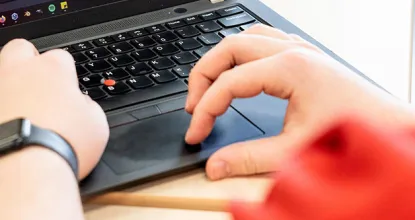The department houses specialized laboratories that you'll find useful throughout your undergraduate career at NMU. These include:
Linux Lab
The computer science laboratory is a flexible multi-use space where computer science students and professors can find the equipment and room to build things, do experiments, develop systems, or just hang out.
Typical uses include:
System Administration Laboratory
We give each student a working system. Then a professor breaks in and vandalizes each system in a different way. The student must repair the system and get it working again.
Robot Building
Each team of two students is given a micro-processor board and various sensors. They choose their own robot body from examples like a remote controlled car or person carrying scooter. The team constructs a robot from these parts. This activity can take an entire semester.
Robot Programming
Each team of two students gets a small pre-built robot. They must program the robot to navigate on a table top without falling off. Any bug in their program causes the robot to crash to the floor (and brings a professor over quickly).
Video Game Programming
A small group of students is working on a video game. They will typically have the video game world drawn on large papers scattered around while coding their world. Loud explosion noises and background music dominate the room.
Experiments
This is one of several places we have for computer experiments. Each experimental group can have a space to themselves where they work. The room itself is filled with posters announcing the results of past experimental groups. Experiments have included measuring the performance of computer systems under various loads, creating new forms of life using various artificial intelligence techniques, and using computers to write original music. Many such teams go on to give conference presentations at regional and national conferences.
Hanging Out
This is a nice place to go between classes. There will almost always be other students to talk with, and occasionally a movie or cartoon will be playing.
Art Competition
For some reason an art competition has become a tradition in the lab. Students doodle on the chalkboard, professors avoid using that part of the chalk board, and the best doodle wins. Some of the art is quite sophisticated (for chalk board art).
Equipment
Equipment varies with needs, but is always kept up-to-date. Currently it includes:
- 30 up-to-date workstations
- 2 video game workstations with specialized graphics cards, controllers (i.e. car steering wheel, joystick, etc.) and 3D Game Studio
- 16 Robots
- 36 Network Jacks (plus wireless)
- DVD and VCR players, Overhead Projector, Sound System, and furniture for your lounging pleasure.
Northern Evolution & Robotics Lab (NERL)
The NERL is home to research projects and experiments involving:
- mobile, intelligent robots
- simulated robots and intelligent agents in virtual worlds
- artificial evolution of robots and agents
- artificial evolution for design, optimization, and problem-solving
The NERL has launched the following initiatives:
BREVE-Cluster
Located in NSF 1013, the Breve-Cluster is a student-led effort that utilizes the computers replaced by the Unix lab and Beowulf upgrades to run a dedicated network of processors for the purposes of simulating evolution using the Breve open source, 3D simulation engine, currently popular in the artificial life research community and brought back to NMU by Mr. Kowall after he visited the 2005 Genetic and Evolutionary Computation Conference (GECCO) in Washington D.C. in June, 2005 to present his paper on evolving robots.
CAT-Cluster
Northern's supercomputer lab will enable faculty and students to split large tasks into smaller pieces that can be run simultaneously on multiple processors, achieving faster results.
Parallel processing is not a new concept, but we now have nine boxes, or the equivalent of 18 computers in a small space. This means programs can be run 18 times faster than if a single computer were used. The applications for this extend beyond math research and instruction. It can be used for any of the sciences that require high-speed computing. Simulations that used to take days could be completed in half a day with this system.
